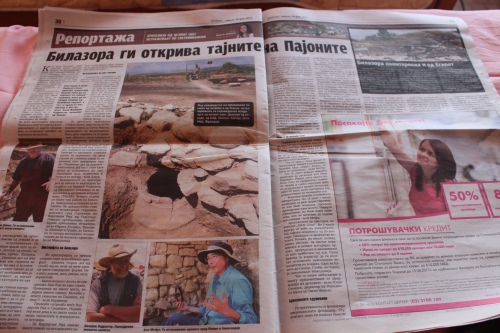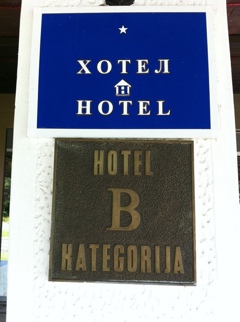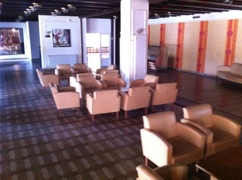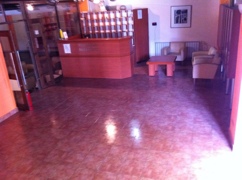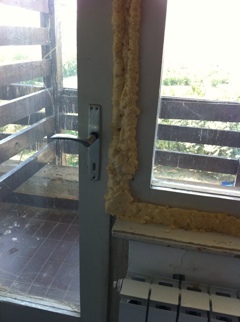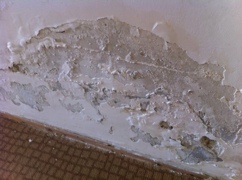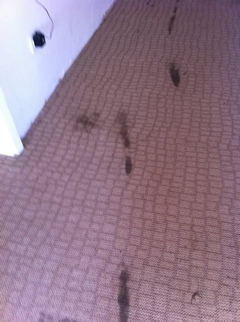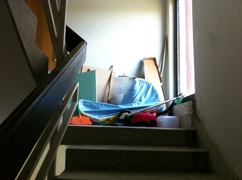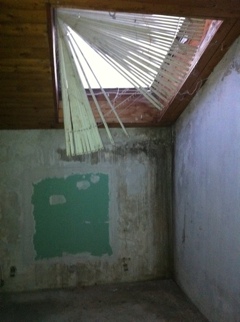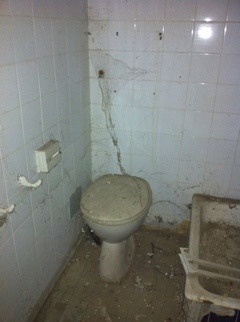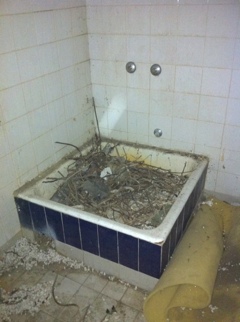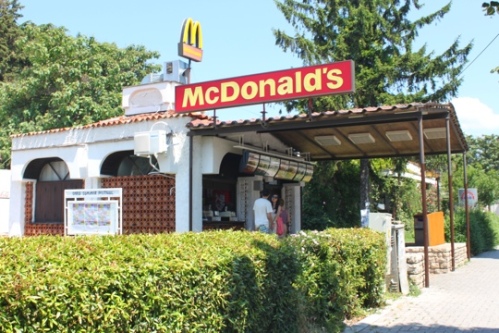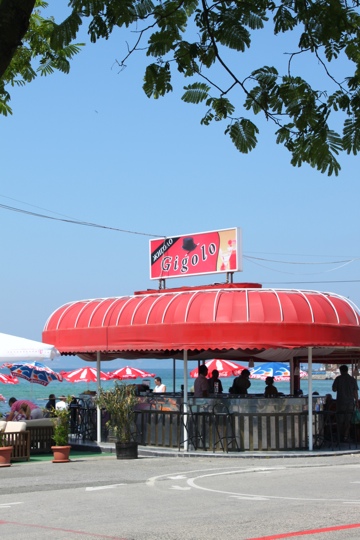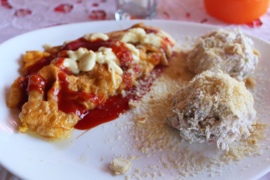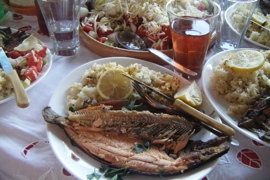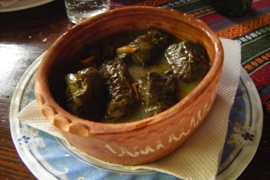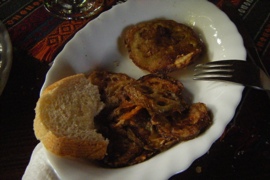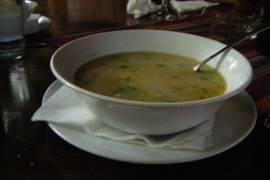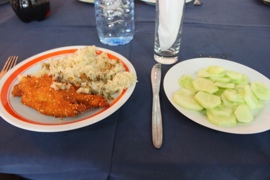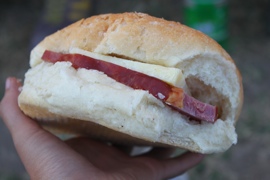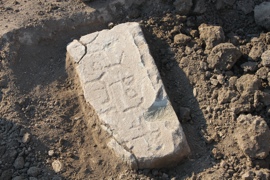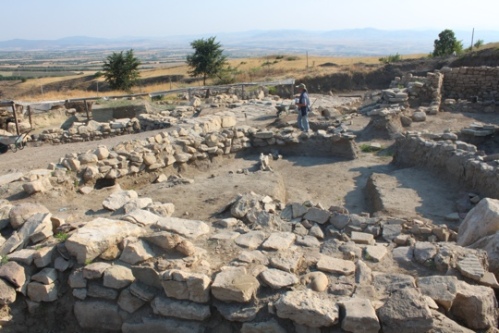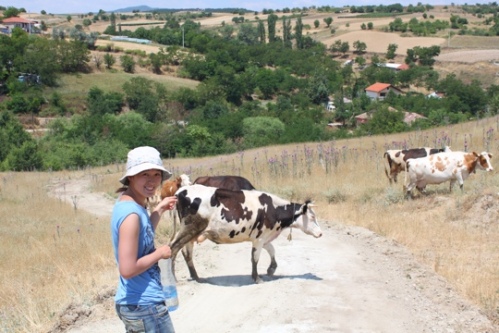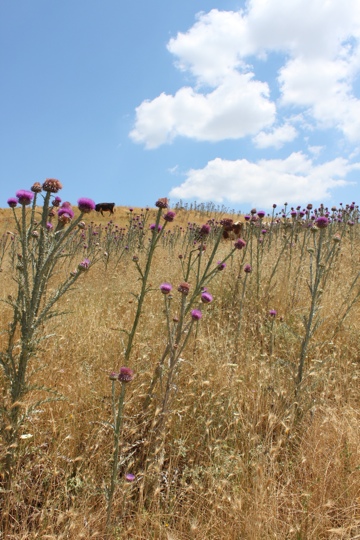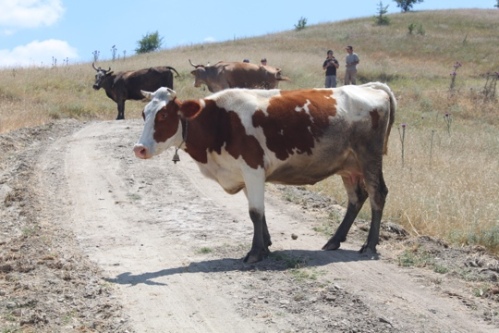Bylazora made it to Macedonian national newspapers! The headline on the left says “Bylazora uncovers the secrets of the Paionians” and the headline on the right says “Bylazora is more interesting than egypt”. Unfortunately I don’t understand enough of the article to figure out what these said secrets are/ how it’s more interesting than Egypt 🙂
Update #3
July 16, 2011
Uncategorized Dig Leave a comment
Dear Friends and Supporters of TFAHR:
Although the summer heat and humidity have arrived in Sveti Nikole, we nonetheless had a very productive week at Bylazora. The week started out with the discovery of an inscribed stone in one of our new squares on the acropolis. The letters are clearly Greek, but it does not appear that the language is either ancient Greek or the ancient Macedonian dialect. We are researching the inscription to determine if what we have is an inscription in the ancient Paionian language. The shape of the letters dates the inscription to the 3rd – 2nd century BC. This is entirely consistent with the other artifacts we have uncovered in this particular building, which dates to the last days of Bylazora (early 2nd century BC).
In the same room that the inscription came from, a number of other interesting artifacts were discovered: an iron spatula or incense shovel and a number of loom weights with a stamped image of the goddess Athena, the patroness of weavers. In an adjacent room, we cleared a mass of broken amphorae and pithoi, the latter of which had rims with inscriptions probably indicating the contents and volume of these storage vessels. Again, the letters are all Greek.
Elsewhere on the acropolis, we continued our excavations into the Iron Age stratum (7th – 6th century BC). We cut a section through a massive collapsed clay wall to uncover a great deal of datable Iron Age pottery beneath.
As we plan for future excavations at Bylazora, we opened a long test trench on a terrace beneath the acropolis. Already after just two days of excavation the tops of several thin walls have emerged. Their thinness is indicative of domestic architecture, rather than of large public buildings. Our operating hypothesis is that this middle terrace is where most of the people of ancient Bylazora lived. We will concentrate our efforts in the last two weeks of work in this area.
As the dig draws to a close, many of the TFAHR International Field School members are now occupied with drawing the ground plans and stratigraphical sections of the trenches we excavated this year. Several Field School members are also working on research to be presented later this fall. And many of the discoveries of this season are prompting us to revise some of our hypotheses about ancient Bylazora.
We thank you for your continuing support. Please feel free to forward this update to any interested parties.
Best regards,
Eulah Matthews and Bill Neidinger
Ovce Pole 2
July 13, 2011
Uncategorized Sveti nikole 1 Comment
I have written a blog entry under the same title before, but today I will present you with photos of the real ovce pole. As I have mentioned before, this is a hotel that was built around thirty years ago as a business venture as it is along a major highway. Unfortunately, this highway got bypassed by another more important highway. Thus, hotel Ovce Pole has slowly fallen into oblivion and disrepair. Nowadays, it manages to survive by hosting weddings on the weekends, providing a venue for politicians & their affairs, and by housing archaeologists.
There is an interesting phenomenon in this 5-story, b category hotel that the higher up you go, the worse the rooms are.
First and second floors
The first and second floors are not photographed, as they are nicer and not where we live. They have air conditioning, television, and sound-proof doors.
Third and Fourth Floors
The third and fourth floors are where the Bylazora participants are housed. Here’s a sampling of our accommodation
Bedroom…normal so far
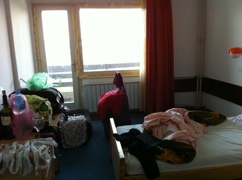
Sealed window with styrofoam stuff too prevent wind
We got a balcony too! But it is full of bird poop
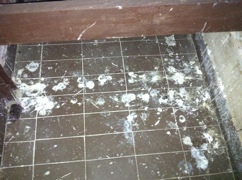
Bathroom: sink and bathtub are drained through a tube that lets the water out into a hole on the ground
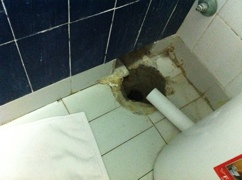
Last but not least…
The Fifth Floor aka Haunted House
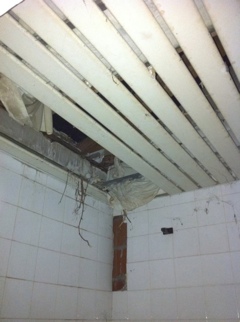
Don’t worry! No one actually lives on the fifth floor, except for birds
Sightings
July 12, 2011
Food: The good, bad, and the ugly
July 11, 2011
Uncategorized Dig, Sveti nikole, Travel Leave a comment
Macedonian staple food is tomatoes, onions, cucumbers, and yogurt, plus some sort of meat dish. It is generally quite good, except at the hotel ovce pole. More about that later. I will start with the good food.
The Good
At Ohrid, for breakfast the hotel owner lady Mira made us omelette with ham salad:
That night, she made us dinner. It was fantastic. Skopska salad (typical macedonian salad; i probably spelled it wrong) with fish and lemon
The night before, we ate sarma, which is a greek dish of rice and meat wrapped in grape leaves and cooked in broth
Fried zucchini, also from that night
Really good fish soup. This was all for under ten bucks
The Bad
As I have mentioned before, our hotel ovce pole is not the best hotel in the world. They also supply our daily meals, which is breakfast, lunch, and dinner. Over my past two weeks here, I have had one meal that I considered good and ate everything. Usually we just feed most the leftovers to the cat Hector. Food at the hotel is overwhelmingly salty. We usually get an appetizer – salad which is some combination of cucumbers, tomatoes, pepper, and onion. The main dish is usually something fried, like salty breaded chicken as tonight’s dinner shows.
The Ugly
Breakfast, which we eat on site at 8am, is also prepared by the hotel. It’s always either a bun with a slab of cheese + unidentified meat slice, or bread with unevenly spread out feta cheese, and yogurt on some days
And there you have it! A cursory review of the delicacies and pitfalls of the Macedonian diet.
Archaeological finds
July 11, 2011
Uncategorized Dig Leave a comment
Everyday, we find dozens of pottery pieces. In fact, we find so many that we discard the uninteresting pieces (body shards that we can’t identify the type of pottery with) and keep diagnostic pieces such as rims, bases, decorations.
A decorated body shard:
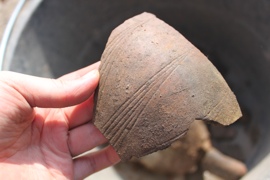
A newly excavated pottery piece:
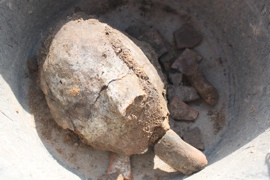
Sometimes, we find more exciting things…
Last week, we found a little bronze jug. So cute!
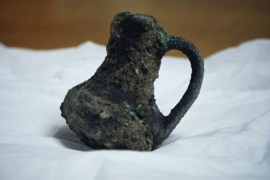
Today, we found a tablet that has an inscription on it. It is a first for the site. The writing is in greek letters but the language probably is not greek. Paionian?? People we’re joking about whether or not the sign says “Welcome to Bylazora” and Bill, the head archaeologist, joked that it says “Bylazora, 25km south”, which would mean that we have been digging for nothing. Hehe!
Macedonian worker cleaning off the stone (these middle aged macedonian workers like to work topless especially when it’s hot.. Urgh. Bill is the bearded man in the back):
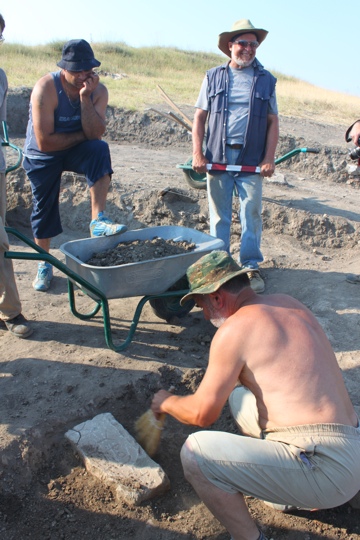
The stone:
Our site!
Trowel
July 11, 2011
Uncategorized Dig, techniques Leave a comment
They say that a trowel is an archaeologist’s best friend. This is my trusty 5 inch marshalltown trowel. 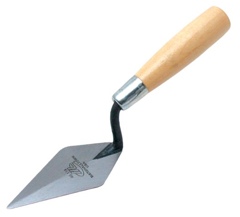
size matters!
We had to bring our own trowels because they can’t be found in Macedonia. Archaeologists use trowels for detail work – for example we uncovered clay surfaces, pebble surfaces, pottery, bones, and more using the trowel. Basically, when you wish to define something slowly you use your trowel. Depending in what you’re trying to do you use different parts of the trowel. If you’re trying to scratch without removing any shards, use to back blade. If you’re trying to define the edges, use the pointy edge. I’m going to be bringing my trowel back home and use it for everything!
Ohrid
July 9, 2011
Uncategorized Travel 1 Comment
This weekend, the team is at Lake Ohrid for a well deserved vacation. Ohrid is a scenic lakeside city in southern Macedonia, and it took about three hours to reach the city. It is an important city is Baltic history – it’s where the Cyrillic alphabet was invented. Ohrid is the only semi touristy place in Macedonia. However, it is catered more towards local tourism. On the other side of this massive lake is Albania. I heard that Macedonia, which is a landlocked country, has one navy ship and it is stuck in Lake Ohrid and it’s to guard the Macedonian-Albanian border.
Scene from the balcony of our hotel/apartment
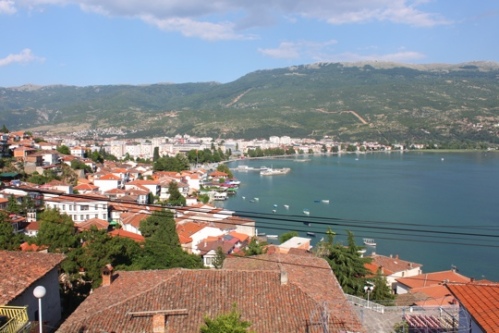
We got some cherries at the fresh fruit market
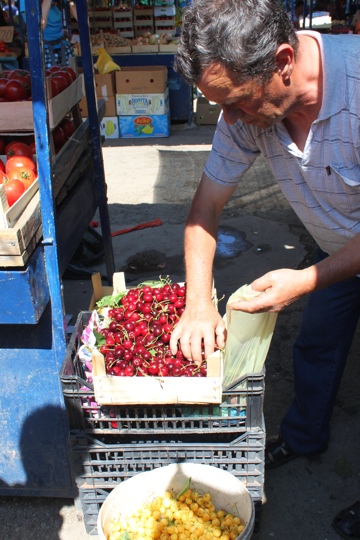
Me!
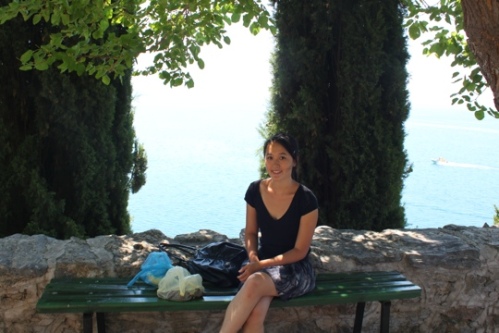
A lakeside monastery 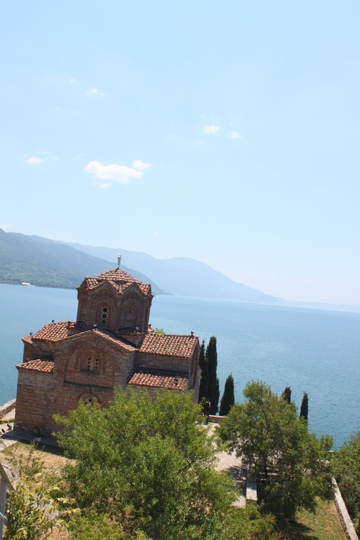
Excavation update letter
July 9, 2011
Uncategorized Dig Leave a comment
Dear Friends and Supporters of TFAHR:
As we enter the sixth week of our excavation season at Bylazora, we have been joined by the last of our new TFAHR International Field School members, from the USA, France and Spain. As we dig deeper in some of the trenches which we had opened in the 2008 season, we are delving into the earliest strata in the history of Bylazora. After removing a pebble and plaster floor of the Classical period, we uncovered a massive destruction layer consisting of the remains of clay walls, wattle and daub buildings, and small hearths. But immediately adjacent to these buildings, which had all been destroyed by fire, was an unburnt solid clay wall (originally at least 1.75 meters tall) which had fallen and collapsed onto its side. Friday we decided to cut a section through this collapsed wall to see what lay beneath. The stratigraphy in this sector of the acropolis is now becoming very complicated and interesting, and we are beginning to map out how the various historical strata lay upon one another.
Due to some unexpected late donations, we were able hire a bulldozer to remove about 85 cubic meters of topsoil and prepare an area for further excavation just south of our old trenches in Sector 3 of the acropolis. Already, we have begun uncovering walls dating to the 2nd century BC. On Friday, just before quitting time, we discovered a thick pavement made of pebbles and river stones. Alongside one of the walls, the top of a large pithos (underground storage jar) was unearthed. In this area we also found a number of pieces of pottery dating to the late Hellenistic or perhaps the early Roman period.
Our weekly lecture series continued with a presentation by one of the TFAHR International Field School members concerning burials in ancient China. This weekend we are currently at Lake Ohrid for the last TFAHR sponsored field trip of the season.
We look forward to an exciting three more weeks of digging, and we thank you for your continuing support. Please feel free to forward this update to any interested parties.
Best regards,
Eulah Matthews and Bill Neidinger
Cow friends
July 7, 2011
